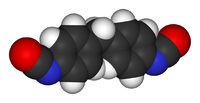Methylene diphenyl diisocyanate
 |
|
| Names | |
|---|---|
|
Preferred IUPAC name
1,1'-Methylenebis(4-isocyanatobenzene)
|
|
| Other names
Bis(4-isocyanatophenyl)methane
1-Isocyanato-4-[(4-isocyanatophenyl)methyl]benzene 4,4'-Methylene diphenyl diisocyanate 4,4'-Diphenylmethane diisocyanate Bayer Desmodur 44 Methylene bis(4-phenyl isocyanate) Pure MDI |
|
| Identifiers | |
|
101-68-8 |
|
| 3D model (Jmol) |
Interactive image Interactive image |
| ChEBI |
CHEBI:53218 |
| ChemSpider |
7289 |
| ECHA InfoCard | 100.002.697 |
| PubChem | 7570 |
| RTECS number | NQ9350000 |
| UNII |
B0LO6BBS8C |
|
|
|
|
| Properties | |
| C15H10N2O2 | |
| Molar mass | 250.25 g/mol |
| Appearance | white or pale yellow solid |
| Density | 1.230 g/cm3, solid |
| Melting point | 40 °C (104 °F; 313 K) |
| Boiling point | 314 °C (597 °F; 587 K) |
| Reacts | |
| Vapor pressure | 0.000005 mmHg (20°C) |
| Hazards | |
|
EU classification (DSD)
|
Harmful (Xn) |
| R-phrases | R20, R36/37/38, R42/43 |
| S-phrases | (S1/2), S23, S36/37, S45 |
| Flash point | 212–214 °C (Cleveland open cup) |
| Lethal dose or concentration (LD, LC): | |
|
LD50 (median dose)
|
2200 mg/kg (mouse, oral) |
|
LDLo (lowest published)
|
31,690 mg/kg (rat, oral) |
|
LC50 (median concentration)
|
369 mg/m3 (rat, 4 hr) 380 mg/m3 (rat, 4 hr) 178 mg/m3 (rat) |
| US health exposure limits (NIOSH): | |
|
PEL (Permissible)
|
C 0.2 mg/m3 (0.02 ppm) |
|
REL (Recommended)
|
TWA 0.05 mg/m3 (0.005 ppm) C 0.2 mg/m3 (0.020 ppm) [10-minute] |
|
IDLH (Immediate danger)
|
75 mg/m3 |
| Related compounds | |
|
Related Isocyanates
|
Toluene diisocyanate Naphthalene diisocyanate Hexamethylene diisocyanate Isophorone diisocyanate |
|
Related compounds
|
Polyurethane |
|
Except where otherwise noted, data are given for materials in their standard state (at 25 °C [77 °F], 100 kPa).
|
|
|
|
|
| Infobox references | |
Methylene diphenyl diisocyanate, most often abbreviated as MDI, is an aromatic diisocyanate. Three isomers are common, varying by the positions of the isocyanate groups around the rings: 2,2'-MDI, 2,4'-MDI, and 4,4'-MDI. The 4,4' isomer is most widely used. This isomer is also known as Pure MDI. MDI reacts with polyols in the manufacture of polyurethane. It is the most produced diisocyanate, accounting for 61.3% of the global market in the year 2000.
Total world production of MDI and polymeric MDI is over 5 million tonnes per year (Mt/a in 2011). The largest producer is Covestro (ex Bayer MaterialScience) followed closely by Yantai Wanhua. Other major producers are BASF, BorsodChem, Dow, Huntsman, Nippon Polyurethane Industry, OCI. All major producers of MDI are members of the International Isocyanate Institute, whose aim is the promotion of the safe handling of MDI and TDI in the workplace, community and environment.
The first step of the production of MDI is the reaction of aniline and formaldehyde, using hydrochloric acid as a catalyst to produce a diamine precursor under the chemical formulation:
2 C6H5NH2 + CH2O → CH2(C6H4NH2)2 + H2O
Then, these diamines are treated with phosgene to form an MDI. The isomer ratio is determined by the isomeric composition of the diamine. Distillation of the MDI mixture gives polymeric MDI (a mixture of oligomeric polyisocyanates) and an MDI isomer mixture which has a low 2,4' isomer content. Further purification entails fractionation of the MDI isomer mixture.
The positions of the isocyanate groups influences their reactivity. In 4,4'-MDI, the two isocyanate groups are equivalent but in 2,4'-MDI the two groups display highly differing reactivities. The group at the 4-position is approximately four times more reactive than the group at the 2-position due to steric hindrance.
...
Wikipedia
